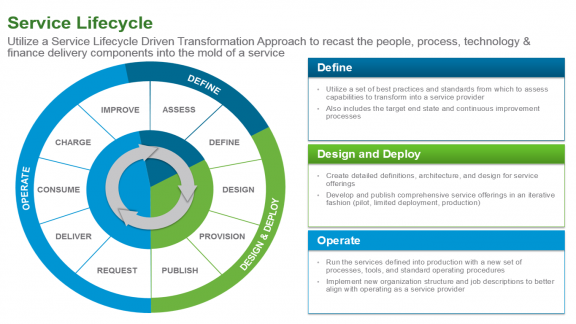Today, IT is project-oriented. IT uses “projects” as the construct for managing work. These projects frequently begin their lifecycle as an endeavor chartered to implement new applications or complete major enhancement or upgrades to an existing application. Application projects trigger work in the infrastructure/engineering teams, e.g., provision new environments include compute, storage, network and security, with each project having its own discrete set of infrastructure provisioning activities.

This project-oriented approach results in many challenges:
- There is a tendency to custom-build each environment for that specific application. The lack of standardization across the infrastructure for each application results in higher operational and support costs.
- Project teams will over-provision infrastructure because they believe they have “one shot” at provisioning. Contrast this to a cloud computing mindset where capacity is elastic, i.e., you procure just enough capacity for your immediate needs and can easily add more capacity as the application grows.
- The provisioned infrastructure is tied to the project or application. Virtualization allows IT to free-up unused capacity and utilize it for other purposes, reducing the overall IT cost for the organization. However, the project or application team may feel like they “own” their infrastructure since it was funded by their project or for their application, so they are reluctant to “give up” the unused capacity. They do not have faith in the elasticity of the cloud, i.e., they do not believe that when they need more capacity, they can instantly get it; so they hoard capacity.
- A project orientation makes an organization susceptible to understating the operations cost in the project business case.
- It makes it difficult to compare internal costs with public or hybrid cloud alternatives – the latter being service-oriented costs.
When IT adopts a service-oriented mindset, they define, design and implement the service outside the construct of a specific application project. The service has its own lifecycle, separate to the application project lifecycles. Projects consume the standardized pre-packaged service. While the service might have options, IT moves away from each application environment since the solutions are custom-built. IT needs to define their Service Lifecycle, just like they have defined their Project Lifecycle. You can use VMware’s Service Lifecycle, illustrated below, as a starting point.
The Service-Oriented Mindset
This service-oriented mindset not only needs to be adopted by the infrastructure/operations team, but also by the application teams. In a service-oriented world, application teams no longer “own” the specific infrastructure for their application, e.g., this specific set of virtual machines with a given number of CPUs, RAM, storage, etc. Instead, they consume a service at a given service level, i.e., at a given level of availability, with a given level of performance, etc. With this mindset, IT can provide elastic capacity, (add capacity and repurpose unused capacity) without causing friction with the application teams.
The transformation from a project-orientation to a service-orientation is a critical part of becoming a cloud-enabled strategic service provider to the business. When IT provides end-to-end services to the business, the way the business and IT engage is simplified, services are provisioned faster and the overall cost of IT is reduced.
Reg Lo is the Director of VMware Accelerate Advisory Services and is based in San Diego, CA. You can connect with him on LinkedIn.






